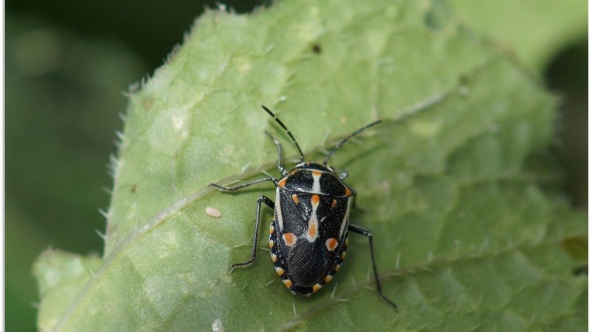Bagrada bug is native to South Africa, the middle east, Asia and is also found in southern California. This unique bug has some special features which separate it from other common bugs like a ladybird. It has a shield-like black body with white and orange spots on its body. The adult bug is 5 to 7 mm in length. The female bug is larger than the male bug that also lays eggs. Bagrada bugs are sucking insect pests. They feed on the plants, suck plants sap and make them weak. As they feed on plants and their leaves, the bugs make them punctured. Some plants often die. These bugs are deadly to plants as they destroyed them badly, affecting their growth and making them weak.
Bagrada Bug Life Cycle
The bagrada bug mainly appears in hot dry weather and also in the rainy season. A single bagrada bug can lay up to 10 eggs per day and 100 eggs within 2 to 3 weeks. The eggs are oval and off-white. It takes 5 to 10 days for hatching eggs. The life cycle of the bagrada bug consists of 5 stages. It takes 4 to 5 weeks to complete the life cycle. It has 6 to 8 nymphal stages, molting each time, and is wingless. When it becomes an adult, it gets wings and becomes mature.
Bagrada Bug Chemical Control
Insecticides and some insect-killing sprays are a treatment against bagrada bugs. Chemical treatments used like insecticides are suitable for treating bagrada bugs. Based on some research, a threshold has developed for bagrada bugs, that chemical treatment is only applicable when plant damage exceeds up to 5%. The application of insecticides can temporarily reduce the reproduction of bagrada bugs. Research shows that these insecticides can prevent the growth of bagrada bugs for 14 to 20 days. There is no permanent treatment for its control, so it requires additional navigation of the plants. Treatments through insecticides or pesticides are useful for bagrada bugs.
Bagrada Bug Organic Control
Controlling the adverse effects of such insects is very important. Here are some organic ways through which you can combat the bagrada bug;
Bagrada hilaris is a species of shield bug commonly known as bagrada bug or painted bug. It is an introduced species found in California and Arizona and first reported in 2008. It is a common pest insect of brassica oleracea that is the specie of common plant of many common foods like cabbage, cauliflower, broccoli, etc. the adult bug is 5 to 7 mm in length, shield-shaped, and black with orange and white marks. The female bug is larger than the male. It can lay up to 100 oval-shaped eggs on the leaves and the soil. Bagrada bug is different from a ladybird. Bagrada bug has a shield-like black body with white and orange stripes. Whereas a ladybug has a red-colored body with black dots on it.
● Monitoring
Keep a check on the crop before they cause any harm to it. Research done in Namibia has shown that immediate control measures are necessary if the number of bugs per square meter exceeds one in the early growth stage.
● Sanitation
Sanitation means removing what the bug needs for its survival. Restricting the population development of the bugs may help to eliminate old crops and their weeds.
● Growing strong aromatic plants
A mixture of chili, soap, or growing strong-smell plants like garlic and onion near other plants to which bagrada bugs attack, can effectively control their spread.
● Physical method
Another method that can be used to cover the plants with a net or a cloth to protect them from attacking the bugs.
Bagrada Bug Traps
Spraying insecticides is not more effective for controlling the rapid growth of bagrada bugs. The adult bugs have wings to fly away from the sprays while their eggs remain safe in the soil. The best mechanical control is to vacuum the bugs. Place cardboard or a plastic sheet under the affected plant, shake it so that the bugs can fall, and then the vacuum can remove them effortlessly. Trapping bagrada bugs is important until and unless they destroy the plants.
Quick steps are taken to trap them is a challenge. Various manual methods are applied to prevent their growth, vacuuming, placing net or cloth, spraying chemicals, and growing strong, aromatic plants. All these trapping methods are extremely helpful in controlling their rapid growth. There is no permanent treatment to prevent the plants from bagrada bugs, so these methods will be favorable against them.



